Whether you are an app developer or simply want to run android apps on your computer, you’ll need to run an android emulator. The best program to use is Google’s Android Studio, an app development program that has a built-in emulator.

In this article, you’ll learn how to download, install, and run Android Studio on various platforms. We’ll also cover common problems, explain how an Android emulator works, and provide you with best practices for running the program.
How to Install an Android Emulator?
First, you’ll need to download the installation for Android Studio:
- Go to the official download page for Android Studio.
- Click on “DOWNLOAD OPTIONS.”

- Choose which file to download. Note: This depends on the type of device you are using.

- Locate the downloaded file on your computer and run the installation.

- Follow the on-screen instructions.
How to Run an Android Emulator on Windows?
Once the installation is finished, Android Studio should start automatically. However, if you’ve unchecked “Start Android Studio” in the final step of the installation process, click on the desktop shortcut for Android Studio. If there is no shortcut on your desktop either, run the “studio64.exe” from the folder where Android Studio has been installed.
When you launch Android Studio, you’ll have to go through the setup wizard:
- Click “Next.”

- Check “Standard” if you are using Android Studio for the first time and click “Next.”

- Choose the theme for your interface and click “Next.”
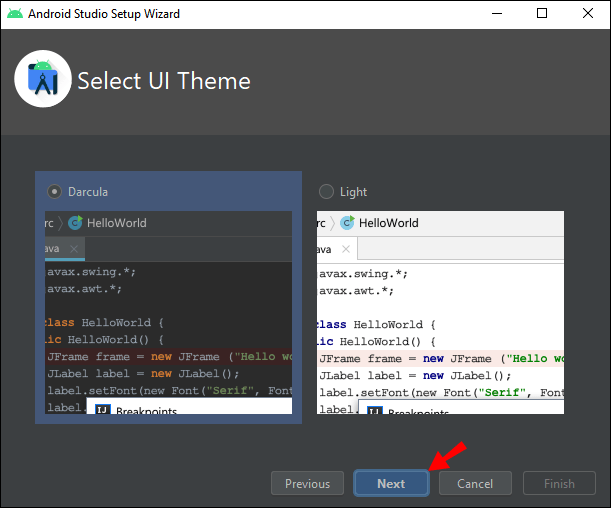
- Click “Finish.”

Android Studio will now download additional components that will enable you to run the emulator. Click “Finish” when the download is over and Android Studio will launch.
- Click on “Start a new Android Studio project.”

- Choose the type of activity that best describes what you want to do using the emulator and click “Next.” Note: If you’re unsure what you want to do, simply select “No Activity.”

- Type in the name of your project, choose the path where you want to save it, choose program language and device, and then proceed.

Now you’ll see the Android Studio interface. The next step is to launch the emulator:
- Click on the AVD Manager button in the top-right corner of the screen.
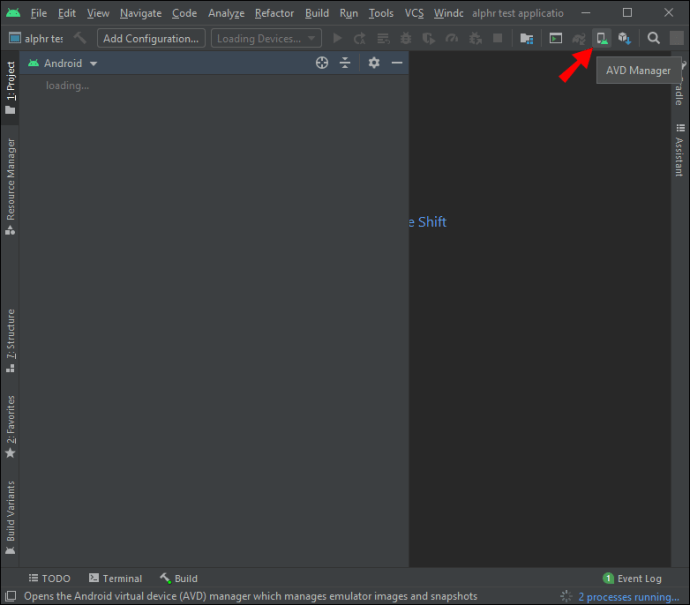
- You will see the emulator of the latest Android version. Click “Run.”

Done! You’ve run the Android emulator on your Windows device. However, if there is no emulator in AVD Manager, you’ll have to create a new one:
- At the bottom of the AVD Manager dialog box, click “Create Virtual Device.”

- Select the hardware profile for your emulator and click “Next.”

- Click on the “x86 system” tab and choose a system image. Note: System images in this section run the fastest in the emulator.

- Check your AVD configuration and click “Finish.”
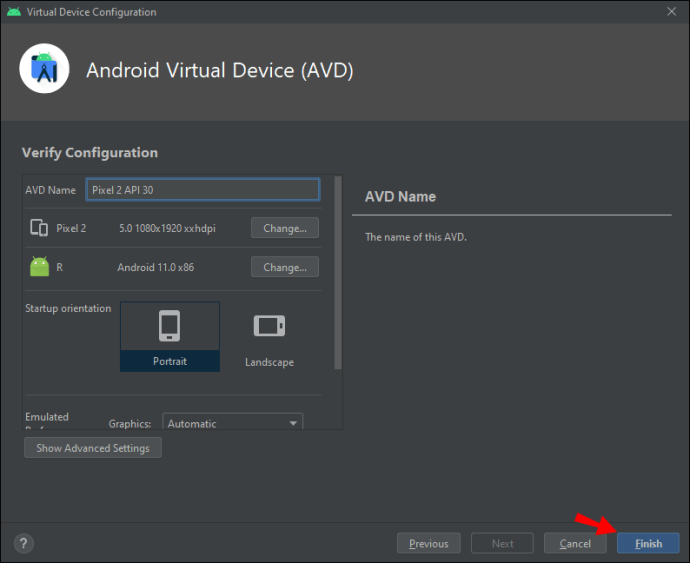
You have created an Android Virtual Device. Finally, run the emulator:
- Select your AVD in the toolbar.

- Click the “Run” button next to the toolbar to start the emulator.
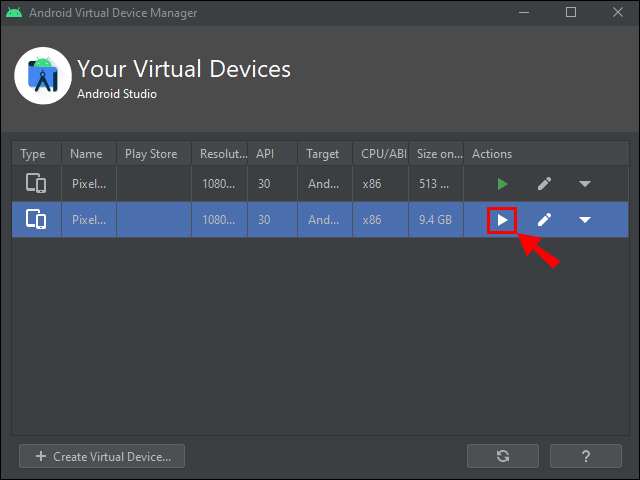
Success! You’ve run the android emulator on your PC.
How to Run an Android Emulator on Mac?
For Mac users, the process of installation is the same. You first have to download the installation for Android Studio (see the beginning of this article). When the download is finished, do the following:
- Run the installation.
- In the dialog box, click and drag the Android Studio icon into the “Applications” folder.

- Go to “Launchpad” and start Android Studio.
- Click “Open.”

- Choose “Do not import settings” and click “OK.”

- Click “Send usage statistics to Google.” Note: This is optional.
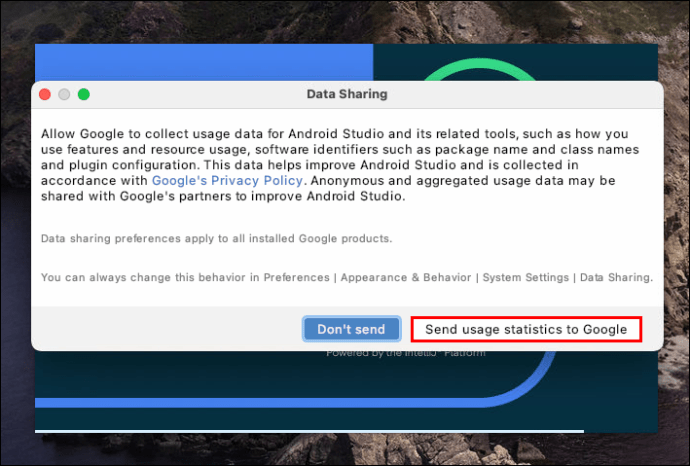
- The Android Studio Setup Wizard is now opened. Click “Next.”
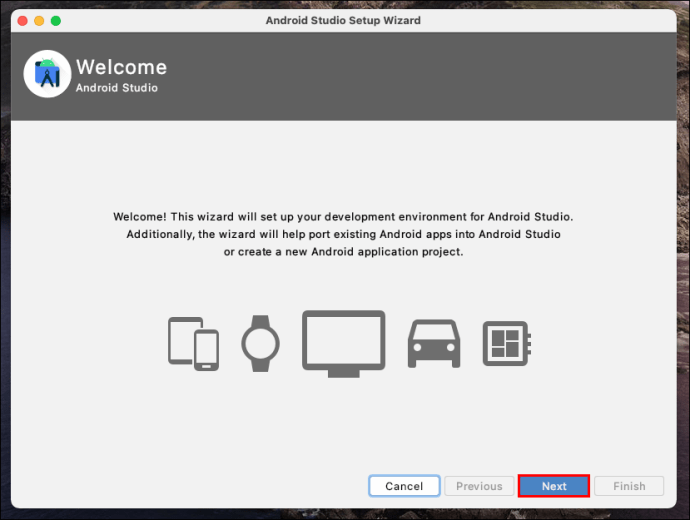
- Check “Standard” if you are using Android Studio for the first time and click “Next.”

- Choose the theme for your interface and click “Next.”

- In the “Verify Settings” dialog box, click “Finish.”

Wait for the additional components to download.
Note: You may be prompted to provide your credentials (username and password) to proceed with the download. This is because your Mac needs your confirmation for downloading these additional components. Type in your username and password and click “OK.”
If the “System Extension Blocked” dialog box appears:
- Select “Open Security Preferences.”
- Click “Allow.”
- When the download is over, click “Finish.”
Android Studio will automatically launch after this. Now, it’s time to create a new project:
- Select “Start a new Android Studio project.”

- Click on “Basic Activity.”
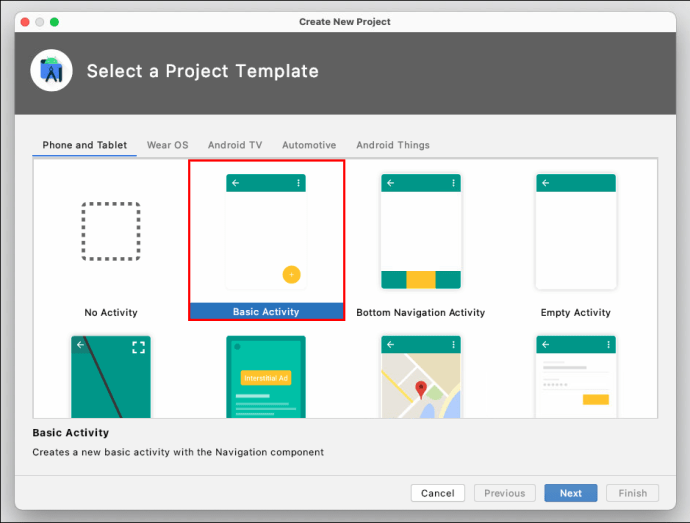
- Type in the name of your project, choose the path where you want to save it, choose program language and device, and then proceed.

You will now see the Android Studio interface. Next, you need to start the emulator:
- Click on “Tools” and put your cursor on “Android.”
- In the extended menu, click “AVD Manager.”

Note: If you see the notification that says “HAXM is not installed,” click on “Install Haxm.” You’ll need this component to run the emulator.
In AVD Manager, you should see the emulator of the latest Android version. Click the “Run” button to start the emulator.
If there is no emulator in AVD Manager, you’ll have to create a new one:
- In the AVD Manager, click “Create Virtual Device.”

- Choose your hardware profile.
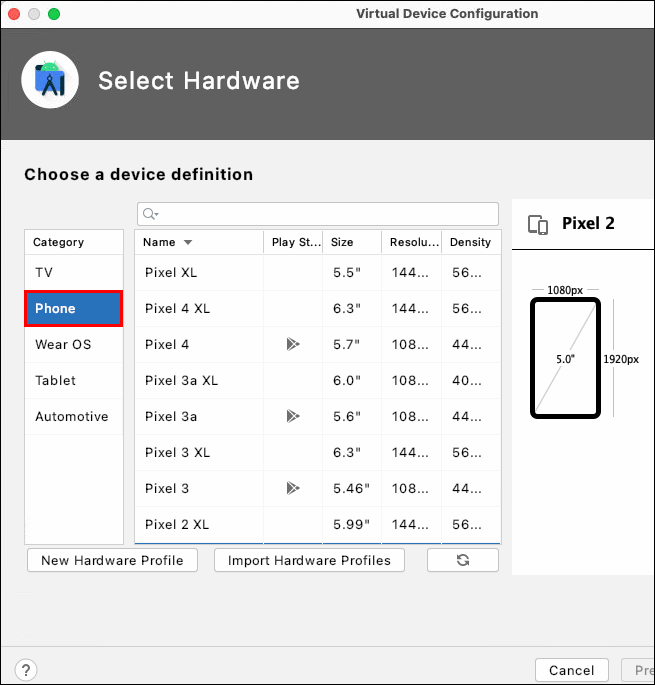
- Select the system image. Note: System images in “x86” section run the fastest in the emulator.

- Check your AVD configuration and click “Finish.”

Now run the emulator:
- Select your AVD in the toolbar.
- Click the “Run” button next to the toolbar to start the emulator.
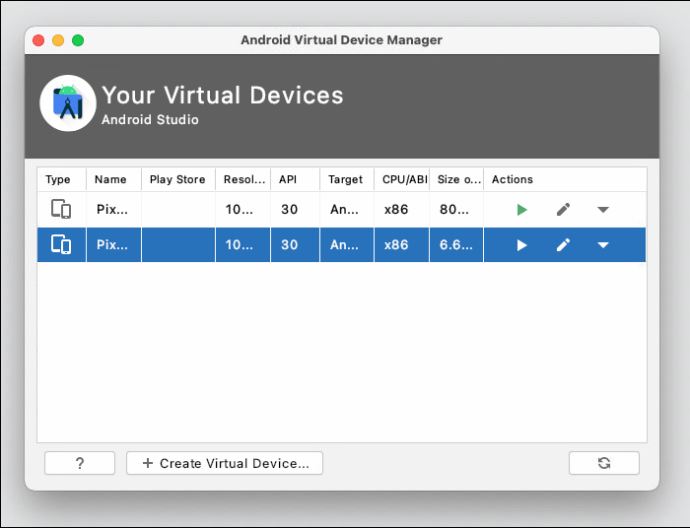
Great! You’ve launched your custom emulator.

How to Run an Android Emulator on iPhone?
Unfortunately, Android Studio is not available for iPhone. To have the Android experience on your iPhone, you’ll need to download an emulator from another developer.
This also means that you’ll have to jailbreak your iPhone. We don’t recommend this as it will prevent iOS from keeping your device safe from potentially malicious software.
How to Run an Android Emulator in Visual Studio Code?
Provided that you already have an Android emulator installed, you can run it from Visual Studio Code.
For Windows and Linux users, press Ctrl + Shift + P and type “emulator.”
For Mac users, press Cmd + Shift + P and type “emulator.”
How to Run an Android Emulator From Command Line?
To run the emulator from the command line, you need to have at least one AVD created. Then, run the emulator from the command line in the following way.
- Open Windows Explorer.
- Go to Local Disk (C:).

- Open the folder “Users” and then go to “User.” Note: The name of this folder may vary according to the language of your OS and your PC account configurations.
- Open the folder “AppData.”

- Go to “Local.”

- Open the “Android” folder.
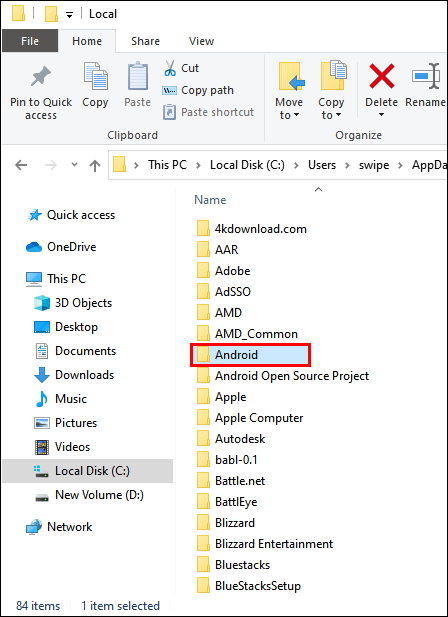
- Go to “sdk.”
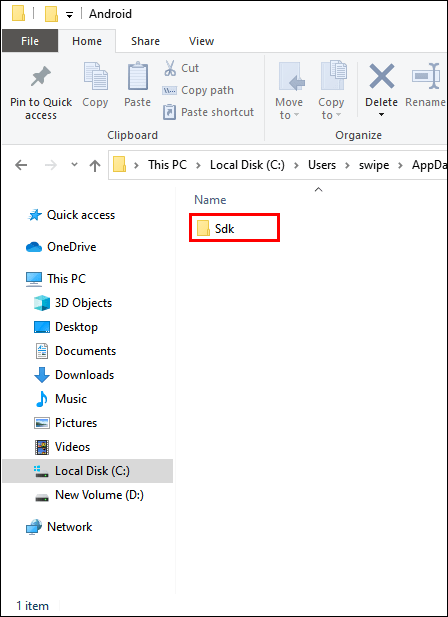
- Double-click on the folder bar at the top and highlight the entire folder path.

- Type in “cmd” and press Enter.

- Enter the following command
emulator -avd <name>and press enter
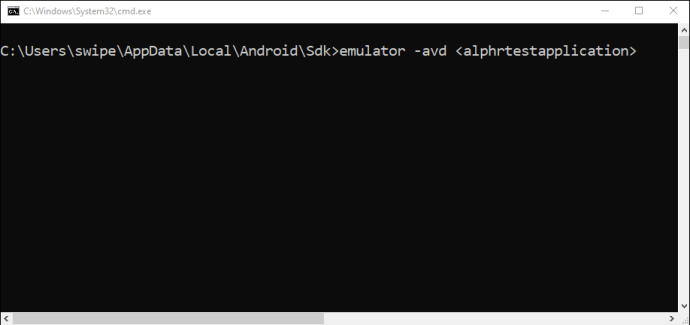
The emulator should run now.
Note: Instead of <name>, enter the actual name of the emulator you want to run.
How to Run an Android Emulator on AMD Processor?
If you own a PC with an AMD processor, you’ll have to enable the Windows Hypervisor Platform.
- In the Windows Search bar, type in “Control Panel” and open the program.
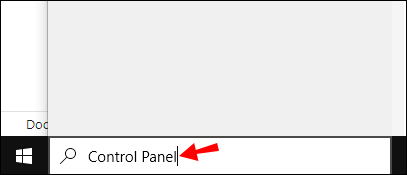
- Click on “Programs.”
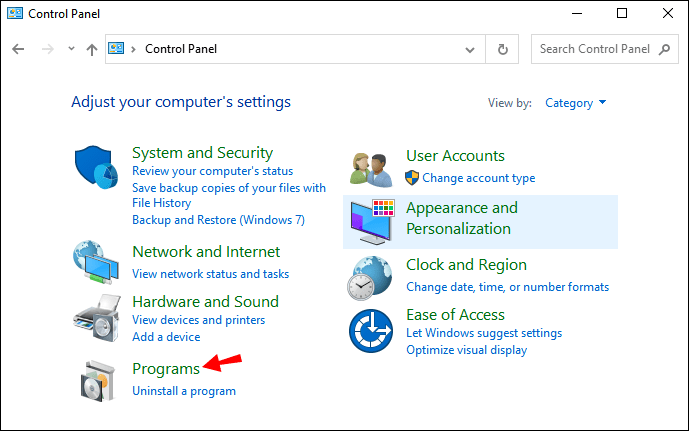
- Open “Programs and features.”

- Click on “Turn Windows features on and off.”
- Check “Virtual Machine Platform” and “Windows Hypervisor Platform.”

Additional FAQs
What Are the Best Ways to Run an Android Emulator on a PC?
Android Studio is the best option to run an Android emulator. It lets you create a custom Android emulator. You can customize software and hardware options to the tiniest degree. Plus, it’s developed by Google, which adds to its credibility.
Alternatively, there are simpler alternatives for Android emulators. This is especially useful to mobile gamers who simply want to play Android games on PC. But don’t expect to have a full-featured program like Android Studio.
How Does an Android Emulator Work?
An Android emulator is a program that lets you use the Android system on your computer. They enable you to run and test apps or play Android games. Remember that they only emulate the Android system. You don’t actually operate within Android when running an emulator.
Can My PC Run an Emulator?
Before you download Android Studio, first check the system requirements to see if your device can support this program. There are other emulators besides Android studio. Check the requirements of each one before downloading to have the most optimal experience.
Running an Android Emulator
There are many Android emulators out there, but it is best that you use Android Studio. Apart from the emulator itself, it offers many other features, like app development and custom emulator creation.
Also, if you use Android Studio only, you avoid the risk of potentially harmful software interfering with your computer. Unfortunately, you can’t run Android Studio on an iPhone. Any alternative for Android emulators for iPhone isn’t safe.
Lastly, we’ve covered solutions for running Android Studio with an AMD processor and initiating an Android emulator in Visual Studio Code.
What Android emulator do you use? Have you had any troubles running it? How did you resolve these issues? Let us know in the comments section.
Original page link
Best Cool Tech Gadgets
Top favorite technology gadgets






0 comments:
Post a Comment